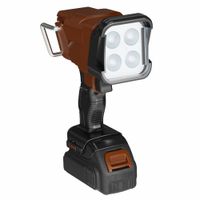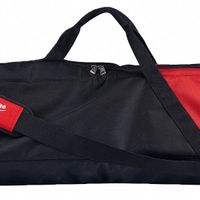Call +(254) 703 030 000 / 751 483 999 / 721 704 777
- Home
- Tools
- Power Tools
- Cordless Tool Lighting
.....Read More
Frequently Asked Questions
What are the best cordless tool lighting brands?
Some of the best cordless tool lighting brands include:
1. **DeWalt**: Known for its durable and high-performance tools, DeWalt offers a range of cordless lighting solutions that are compatible with their 20V MAX battery system. Their lights are designed for rugged use and provide excellent brightness and battery life.
2. **Milwaukee**: Milwaukee's cordless lighting options are part of their M12 and M18 systems, known for their innovation and reliability. They offer a variety of lights, including floodlights, spotlights, and lanterns, with features like TrueView technology for consistent color and brightness.
3. **Makita**: Makita provides a wide selection of cordless lights that are part of their LXT battery platform. Their lights are praised for their energy efficiency, long runtime, and robust construction, making them suitable for various job site conditions.
4. **Bosch**: Bosch offers cordless lighting solutions that are compact and efficient, compatible with their 18V battery system. Their lights are designed for versatility and ease of use, with features like adjustable brightness and flexible mounting options.
5. **Ryobi**: Known for affordability and innovation, Ryobi's ONE+ system includes a range of cordless lights that are versatile and user-friendly. Their products are popular among DIY enthusiasts and professionals alike for their value and performance.
6. **Ridgid**: Ridgid provides durable and reliable cordless lighting options that are part of their 18V battery platform. Their lights are designed for heavy-duty use, offering features like high lumen output and long battery life.
These brands are recognized for their quality, innovation, and compatibility with existing battery platforms, making them top choices for cordless tool lighting.
How long do cordless tool light batteries last?
The lifespan of cordless tool light batteries depends on several factors, including the type of battery, usage patterns, and maintenance practices. Common battery types used in cordless tools include Nickel-Cadmium (NiCd), Nickel-Metal Hydride (NiMH), and Lithium-Ion (Li-Ion).
1. **Nickel-Cadmium (NiCd):** These batteries typically last between 1,000 to 1,500 charge cycles. However, they suffer from the "memory effect," which can reduce their lifespan if not fully discharged before recharging. With proper care, they can last 2 to 3 years.
2. **Nickel-Metal Hydride (NiMH):** NiMH batteries offer a longer lifespan than NiCd, with around 500 to 1,000 charge cycles. They are less prone to the memory effect but can still suffer from it. Their lifespan is generally 3 to 5 years with proper maintenance.
3. **Lithium-Ion (Li-Ion):** Li-Ion batteries are the most common in modern cordless tools due to their high energy density and lack of memory effect. They typically last between 300 to 500 charge cycles. However, they degrade over time, even when not in use, and usually last 2 to 3 years.
**Factors Affecting Battery Life:**
- **Usage Patterns:** Frequent use and deep discharges can shorten battery life. It's best to recharge before the battery is completely drained.
- **Storage Conditions:** Batteries should be stored in a cool, dry place. Extreme temperatures can significantly reduce their lifespan.
- **Maintenance:** Regular cleaning of battery contacts and proper charging practices can extend battery life.
In summary, while the type of battery plays a significant role in determining lifespan, proper usage and maintenance are crucial for maximizing the longevity of cordless tool light batteries.
Can I use any brand's battery with my cordless tool light?
Using any brand's battery with your cordless tool light depends on several factors, including compatibility, voltage, and design. Most cordless tools and their batteries are designed to be brand-specific due to proprietary technology and design differences. Here are key considerations:
1. **Compatibility**: Many brands design their tools and batteries to be compatible only within their own product lines. This means a battery from one brand may not fit or work with a tool from another brand due to differences in connectors and design.
2. **Voltage and Capacity**: Even if a battery physically fits, the voltage and capacity must match the tool's requirements. Using a battery with a higher or lower voltage than specified can damage the tool or reduce performance.
3. **Warranty and Safety**: Using a non-brand battery can void the warranty of your tool. Additionally, safety risks such as overheating, short-circuiting, or even fire can occur if the battery is not designed for the specific tool.
4. **Aftermarket Options**: Some third-party manufacturers produce batteries compatible with multiple brands. These can be a cost-effective option, but it's crucial to ensure they meet the tool's specifications and safety standards.
5. **Adapter Solutions**: Some adapters allow the use of different brand batteries with certain tools. However, these should be used with caution and only if they are specifically designed for the tool and battery in question.
In summary, while it might be possible to use a different brand's battery with your cordless tool light, it is generally recommended to use the battery designed for your specific tool to ensure optimal performance, safety, and warranty protection.
What is the brightest cordless work light available?
The Milwaukee M18 ROCKET Dual Power Tower Light is often considered one of the brightest cordless work lights available. It delivers up to 3,000 lumens of high-definition light output, which is significantly brighter than many other cordless options on the market. This work light is part of Milwaukee's M18 system, which means it is powered by their M18 REDLITHIUM battery packs, providing extended run time and durability.
The ROCKET Tower Light features a dual power source capability, allowing it to be powered by either an M18 battery or an AC extension cord, offering flexibility depending on the work environment. It has a telescopic design that extends up to 7 feet, providing overhead lighting that reduces shadows and covers a wide area. The light head can be rotated and pivoted to direct light where it is needed most.
Additionally, the Milwaukee M18 ROCKET is designed for portability and ease of use, with a compact footprint and a carry handle for easy transport. It is also built to withstand tough job site conditions, with a durable, impact-resistant design.
Overall, the combination of high lumen output, dual power capability, and robust design makes the Milwaukee M18 ROCKET Dual Power Tower Light a top choice for those seeking the brightest cordless work light.
How do I maintain and care for my cordless tool light?
To maintain and care for your cordless tool light, follow these steps:
1. **Regular Cleaning**: Wipe the tool light with a soft, dry cloth to remove dust and debris. For stubborn dirt, use a slightly damp cloth but ensure no moisture enters the device.
2. **Battery Care**: Charge the battery fully before first use and avoid letting it completely discharge. Store batteries in a cool, dry place and remove them from the tool if not in use for extended periods.
3. **Proper Storage**: Store the tool in a clean, dry environment away from direct sunlight and extreme temperatures. Use a protective case if available to prevent physical damage.
4. **Inspect for Damage**: Regularly check for cracks, loose parts, or any signs of wear. Replace damaged parts immediately to prevent further issues.
5. **Avoid Overheating**: Do not use the tool light continuously for long periods to prevent overheating. Allow it to cool down if it becomes too hot.
6. **Use Correct Charger**: Always use the charger specified by the manufacturer to avoid damaging the battery or tool.
7. **Check Connections**: Ensure all connections are secure and free from corrosion. Clean contacts with a dry cloth if necessary.
8. **Follow Manufacturer’s Instructions**: Adhere to the user manual for specific maintenance guidelines and troubleshooting tips.
9. **Avoid Water Exposure**: Keep the tool light away from water and moisture to prevent electrical damage.
10. **Regular Testing**: Periodically test the light to ensure it functions correctly and provides adequate illumination.
By following these steps, you can extend the lifespan of your cordless tool light and ensure it remains in optimal working condition.
Are there waterproof or weather-resistant cordless tool lights?
Yes, there are waterproof or weather-resistant cordless tool lights available on the market. These lights are designed to withstand harsh environmental conditions, making them suitable for outdoor and rugged work environments. They often feature durable casings made from materials like high-impact plastic or rubber, which provide protection against water, dust, and debris. Many of these lights are rated with an Ingress Protection (IP) rating, which indicates their level of protection against solids and liquids. For example, an IP65 rating means the light is dust-tight and can withstand water jets from any direction.
These cordless tool lights are typically powered by rechargeable batteries, often compatible with the same battery systems used in other cordless tools from the same brand, providing convenience and flexibility. They may include features such as adjustable brightness levels, pivoting heads for directional lighting, and hooks or magnets for hands-free operation.
Brands like DeWalt, Milwaukee, and Makita offer a range of weather-resistant cordless tool lights, catering to professionals in construction, automotive, and other industries where reliable lighting is crucial. These lights are designed to perform in various conditions, ensuring that users have consistent illumination regardless of the weather or work environment.
How do I choose the right cordless tool light for my needs?
To choose the right cordless tool light, consider the following factors:
1. **Purpose and Use**: Determine the primary use of the light. Is it for general work, detailed tasks, or emergency situations? This will guide you in selecting the appropriate brightness and features.
2. **Brightness and Lumens**: Check the lumen rating, which indicates the light's brightness. Higher lumens mean brighter light. For general tasks, 100-300 lumens may suffice, while detailed work might require 500 lumens or more.
3. **Battery Compatibility**: Ensure the light is compatible with the batteries of your existing cordless tools to avoid purchasing new batteries and chargers.
4. **Battery Life and Runtime**: Consider how long the light will last on a single charge. Longer runtimes are crucial for extended tasks. Look for models with energy-efficient LEDs for better battery life.
5. **Portability and Weight**: Choose a lightweight and compact design for easy handling and transport, especially if you need to move frequently or work in tight spaces.
6. **Durability and Build Quality**: Opt for a robust design with impact-resistant materials, especially if used in harsh environments. Water and dust resistance can also be beneficial.
7. **Adjustability and Features**: Look for adjustable brightness settings, pivoting heads, or magnetic bases for versatile positioning. Additional features like hooks or stands can enhance usability.
8. **Brand and Warranty**: Consider reputable brands known for quality and reliability. A good warranty can provide peace of mind and protection against defects.
9. **Price and Budget**: Balance your needs with your budget. While higher-end models offer more features, ensure they align with your requirements to avoid unnecessary expenses.
By evaluating these factors, you can select a cordless tool light that best suits your specific needs and preferences.


